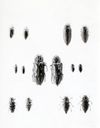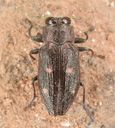Chrysobothris
Chrysobothris
Classification
- Phylum: Arthropoda
- Subphylum: Hexapoda
- Class: Insecta
- Order: Coleoptera
- Suborder: Polyphaga
- Superfamily: Buprestoidea
- Family: Buprestidae
- Subfamily: Buprestinae
- Tribe: Chrysobothrini
- Genus: Chrysobothris
Pronunciation
How to pronounce Chrysobothris: //ˌkrɪsoʊˈboʊθrɪs//
These audio files are automatically generated. While they are not always 100% accurate, they are a good starting point.
Images






Summary
Chrysobothris is a diverse genus of metallic wood-boring beetles found throughout North America, with a significant number of species contributing to the ecological processes in forests.
Physical Characteristics
Metallic coloration, robust body shape typical of wood-boring beetles.
Identification Tips
Look for shiny, metallic appearance; body elongated; presence of distinct patterns or coloration on elytra.
Habitat
Primarily found in wooded areas where they can bore into the wood of trees and shrubs.
Distribution
Widespread throughout North America with more than 30 species reaching Canada; a total of over 680 species globally.
Diet
Larvae are wood-borers and feed on the wood of hardwood trees.
Life Cycle
Undergo complete metamorphosis with egg, larval, pupal, and adult stages; larvae tunnel into wood for feeding.
Reproduction
Reproduce sexually; females lay eggs in or on the bark of trees.
Predators
Natural predators include birds and other insects that prey on beetles.
Ecosystem Role
Play a role in the decomposition of wood by boring into tree trunks; can affect forest health.
Economic Impact
Some species may cause damage to live trees, making them significant in forestry and pest management.
Collecting Methods
- Trapping with baited traps.
- Hand collection from host trees.
Preservation Methods
- Pinning specimens.
- Using ethanol for preservation.
Evolution
Part of the Buprestidae family, they display diversity in form and function adapted to their ecological niches.
Similar Taxa
Misconceptions
Often mistaken for other similar beetles; their ecology and impact on trees are not well understood by the public.
Tags
- beetles
- Chrysobothris
- metallic wood-borers
- Buprestidae